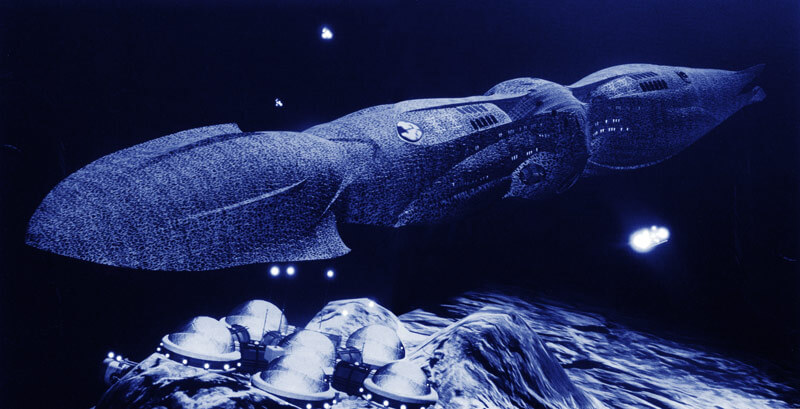
“The twenty-first century. Mankind has colonized the last, unexplored region on Earth; the ocean! As captain of the SeaQuest and her crew, we are its guardians, for beneath the surface lies the future…”
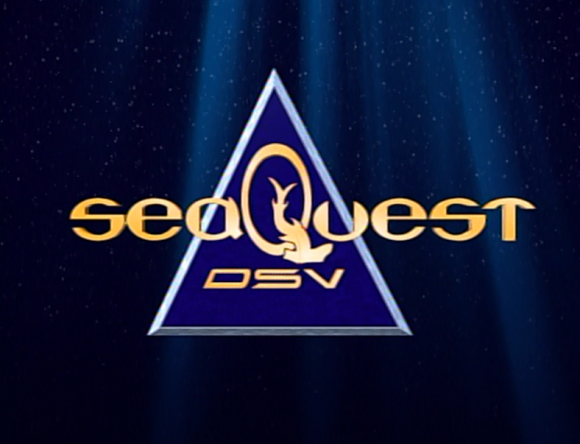
These were the words spoken by Roy Scheider every Sunday night at eight-P.M. during the introductory credits sequence of SeaQuest DSV – 1993’s big budget, sure-fire, must-see-TV event kicking off the Fall season!
Gawddamn – I say, GAWD! DAMN! Did I love this show! I used to bug Liz Bulger at lunch about episodes if I missed it, and when she wasn’t around, I bugged the OTHER girl I knew who watched it, Mary Beth Rew, to see what I had missed. Both of them have the patience of a saint, bless ’em!
Steven Spielberg, riding high post Jurassic Park and acting as executive producer through his company Amblin Entertainment, and boasting the acting talents of his Jaws-star, Roy Scheider, as well as cutting edge (for the time) CGI effects, SeaQuest DSV was an hour-long science-fact-based adventure drama. The pilot and show itself was written and created by a dude named Rockne S. O’Bannon who would go on to create another fan favorite, the Muppets-in-Space epic, FARSCAPE!
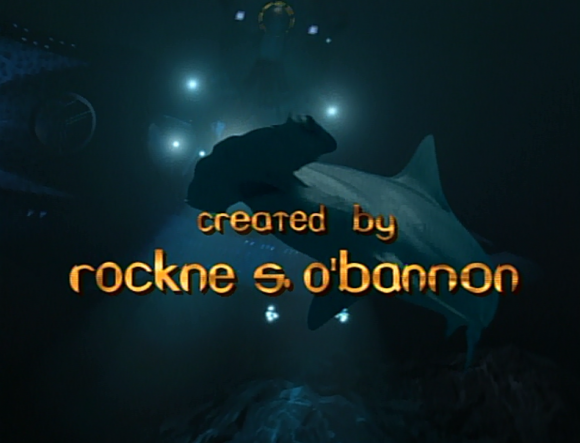
This first season was pure magic. It was a well-thought-out show with a great, intriguing premise about how there was a big ocean floor colonization boom starting in the year 2000 that continued up until 2016/2017 which is when the series takes place, with a very heavily constructed timeline of events and explanation of undersea territories and confederations that often branched off and dwarfed their parental countries. Just great attention to detail. And it was to be, outside the concept of taking place entirely in the ocean, in it’s first season conception, a futurist show that would showcase the real possibilities of what may lie ahead some twenty-five years ahead.
Let’s start with the pilot episode, and work our way from there because we have a lot of ground to cover. A two-hour television film “To Be or Not to Be,” directed by The Empire Strikes Back-Helmer, Irvin Kirschner, establishes some pretty well-thought-out world-building. Y’see, In the (then) future of 2000-2016, there was a BOOM in Oceanic Colonization (this shit is sorta’ happening as I type this, so they weren’t too far off) due to mining and aquatic agriculture. The United Nations crumbled (as I wish it would IRL)* as countries were now recognized by oceanic territories and confederations (don’t worry, the United States, Asia, Russia, etc. are still there).
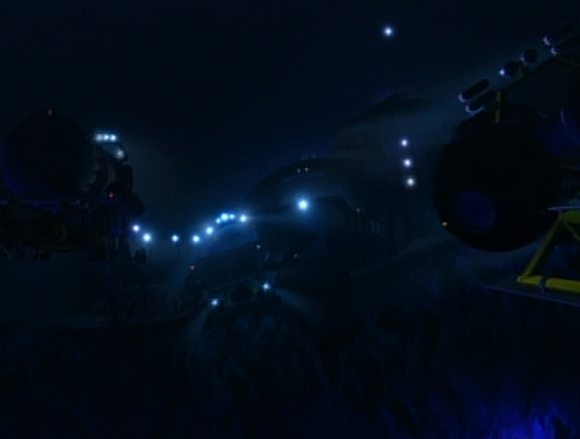
The telefilm starts us off at the beginning at what would be known as the Livingston Trench incident, where upon a united group of confederations had their subs converge on a rival for jack rabbiting (poaching) over their territorial lines. Before things can go all ass-over-tit, the SeaQuest makes her debut – rising majestically out of the trench and laughably dwarfing all the other subs. The SeaQuest is operated by the United States Navy on loan to its confederation, NorPac (North Pacific) and acts as the police. Some how, they got their hands on some stock footage from The Hunt for Red October – specifically when the Red October and the Dallas surface!

Anyways, It’s Captain, Marilyn Stark (Shelley Hack, familiar to audiences as one of Charlie’s Angels), is pissed off by the repeated confrontations she has to deal with and decides, against direct orders, to end the whole thing with a strategic nuclear launch (crazy bitch!) until her Commander, Jonathan Ford (Don Franklin) steps in and removes her from duty, averting the crisis.

We skip ahead over a year and in the wake of the incident, a new, multi-country organization has been formed, the U.E.O. – United Earth’s Oceans/Organization. It’s pretty much the same thing as the United Nations, except for the oceanic confederations (and, y’know, more effective) *.

The SeaQuest herself has been given to the U.E.O. to serve as its flagship and to more effectively handle any future military crisis** that may rise up, but, to build trust and cooperation, it has been refit to act as the ultimate ocean research vessel (in case you’re curious, the DSV stands for “Deep Submergence Vehicle,” NOT “Deep Sea Voyage” or “Deep Sea Vessel” as some idiots like to state). In (desperate need of a Captain since, y’know, the last one went bat-shit cray-cray (seriously; bitch wanted to start WWIII over mineral rights), Admiral Noyce (Richard Herd – T.J. Hooker, Star Trek, the bad guy from Gleaming the Cube) informs Commander Ford that he is to act like a schmuck while giving an old colleague, SeaQuest’s designer and former Naval Captain, Nathan Bridger, a tour of the boat in the hopes that he sees how bumbling Ford is and will assume command.
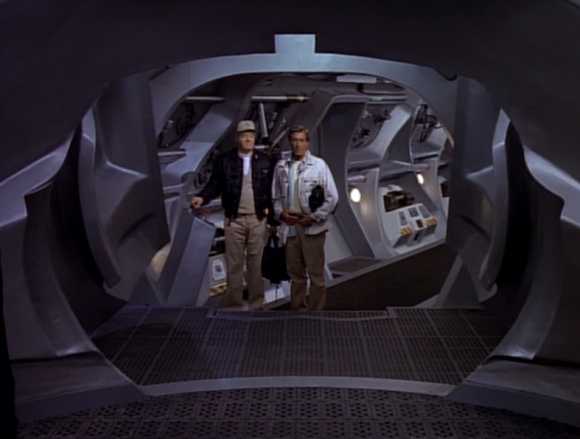
Bridger, you see, left the military when his son, Robert, died and vanished in combat and he promised his wife, Carolyn, he’d never go back. They retreated from civilization to their own private island off the Yucatan peninsula where, sometime before the events of the show, she died. He, did, however, manage to rescue and train a dolphin that he named Darwin, who (I shit you not) becomes one of the crew.
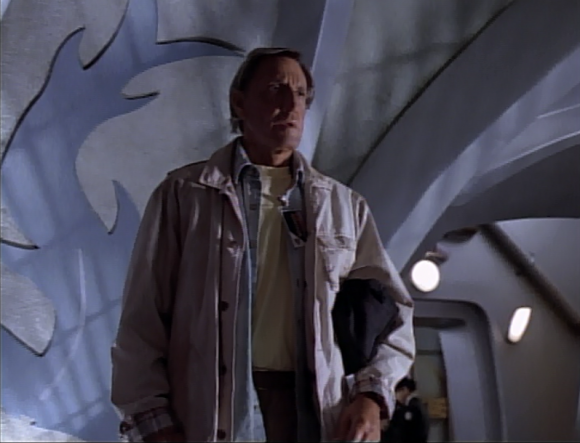
Bridger arrives on the SeaQuest, reluctantly, in berth at Pearl Harbor. On board, we meet the rest of the crew – Chief Engineer Katheryn Hitchcock (Superboy’s Lana Lang, Stacey Haiduk more on her later! Meow…), her former husband and the ship’s resident conman, Lt. Ben Krieg (Jon D’Aquino – the fuckhead who killed farmer Henriksen’s son in Pumpkinhead)…
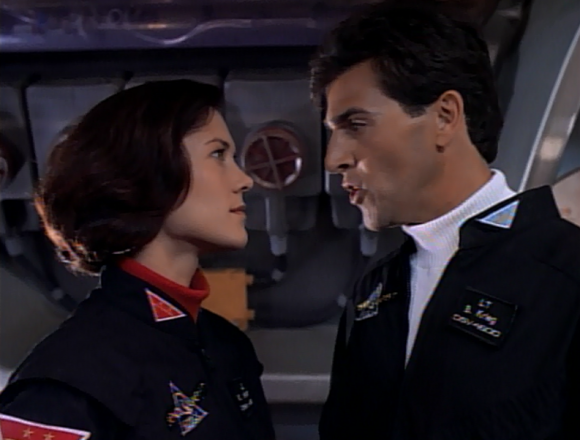
…Lt. J.G. O’Neill, (Ted Raimi, brother of Evil Dead / Spider-Man director Sam Raimi and Joxer on Xena), Sonar Chief Miguel Ortiz (Marco Sanchez, no idea what else he was in), Security Chief Crocker (Royce D. Applegate – Armed and Dangerous, if you saw the flick, he was one of the toxic waste guards) and the ship’s medical Doctor and head of research, Kristin Westphalen (Hammer Hottie Stephanie Beacham who’s still got it at nearly fifty-five here). Rounding out the cast is Jonathan Brandis as teen whiz kid Lucas Wolenczak (my Naval buddy assures me that this wouldn’t fly IRL unless he was a Make-A-Wish kid; they let those kids do anything), dumped on SeaQuest by his father who would feature in the season finale and would be name dropped every couple episodes due to his research work.
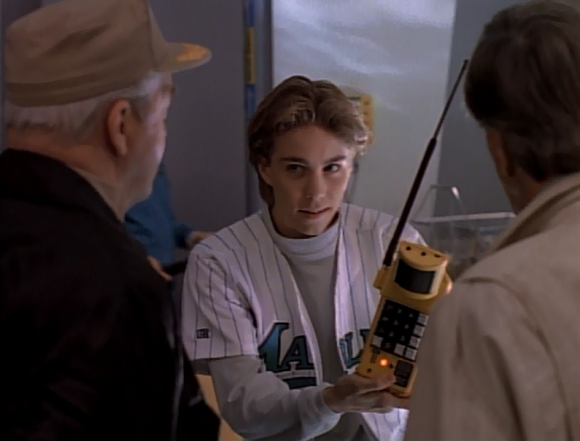
We also discover that Darwin was brought on board and has access to the entire ship via a connecting network of water tubes built especially for him. What’s more is that he can talk to Darwin now; there are electronic sensors in the tank and tubes that translate his clicks and whistles into audible speech. Bridger loses his shit, not that he can understand his dolphin, but rather that they had the nerve to bring him along, too, and demands that he and his dolphin leave at once. Only problem is – whoops – SeaQuest put to sea about twenty-minutes ago by accident.
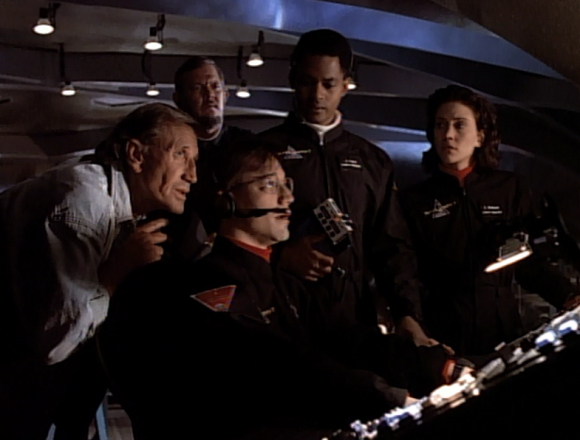
They also neglected to inform Bridger that there’s a Delta IV submarine razing colonies randomly commanded by none other than Marilyn Stark who’s still pissed the Navy dropped her ass for wanting set off nukes.
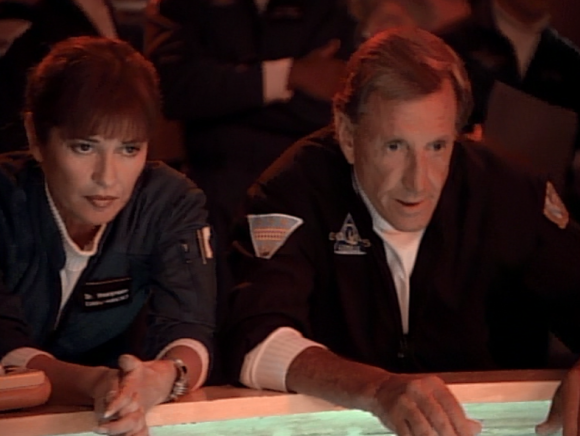
Just as the SeaQuest intercepts them, her systems go down and Bridger is FORCED to assume command (Ford came-clean about his feigned-arrogance and incompetence, stating he was under orders). Bridger discovers Marilyn planted a computer virus on the ship shortly before she was ousted and works with Hitchcock to work around it, ultimately beating Marilyn by using Darwin (in his own little Dolphin scuba-pack) to tag her sub so they can fire a torpedo analog and hone on its signal. The day is saved, everyone is happy and Bridger decides, what the hell, and stays on-board as the SeaQuest’s Captain.
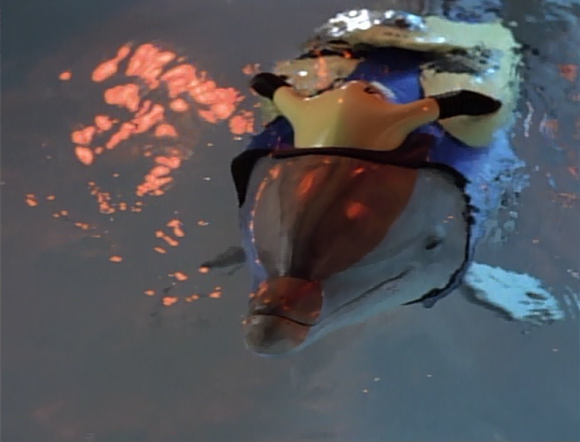
When I watched this at the at the tender age of 15, it was awe-striking! Just that opening credits scene with the CGI shark! Holy shizznit!
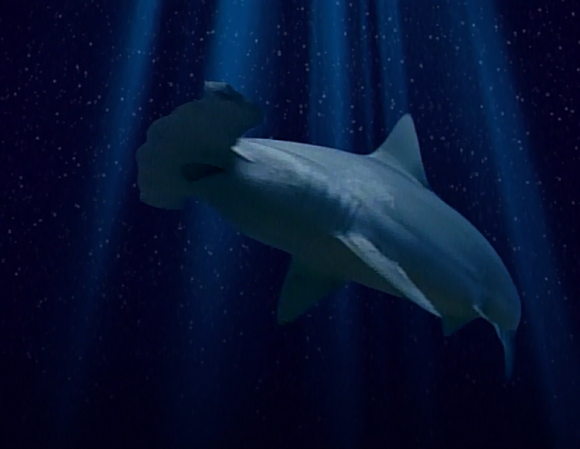
Looking at it as an adult in my late-thirties, I can see many, many flaws, but mostly in the second and third seasons, but I can say this – one of those flaws was NOT the casting of Rosalind Allen! But more on her later…
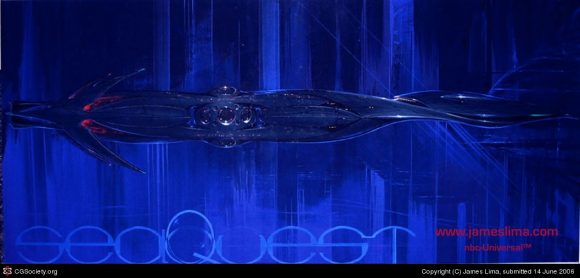
The Good – the look of the show, for starters! Since television is a visual medium, everything looked almost cinema-level, from the costumes to the set and vehicle designs by Richard B. Lewis and James Lima (who also headed up the CGI Unit), everything looks impressive and real.
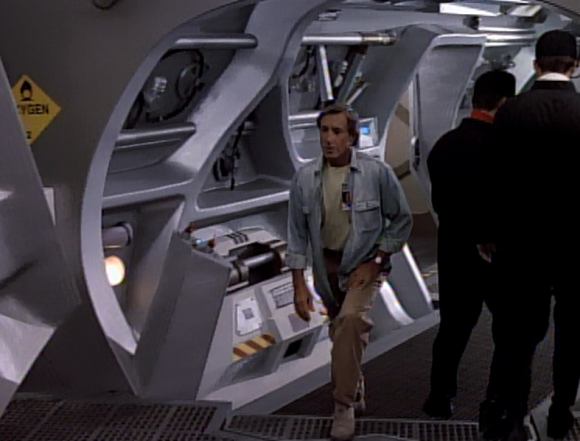
From the interior corridors of the SeaQuest herself to the uniforms worn by the crew (black jumpsuits with a turtleneck shirt that evoke a nautical feel with khaki’s for off-ship / surface excursions) everything looked lavish and that, my friends, is what Spielberg brought to the show as a producer.
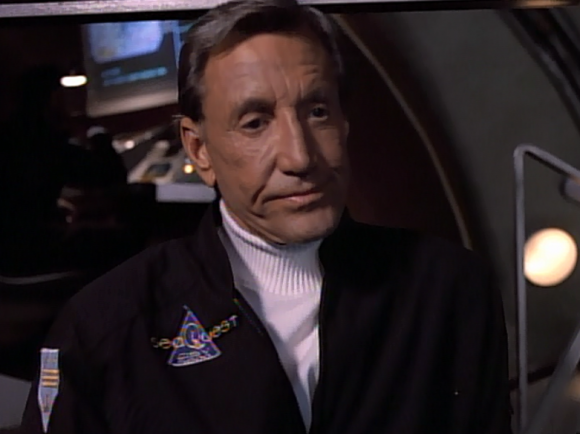
In addition to the SeaQuest, which resembled a giant squid, we got treated to a host of ancillary vehicles that served different purposes throughout the show.
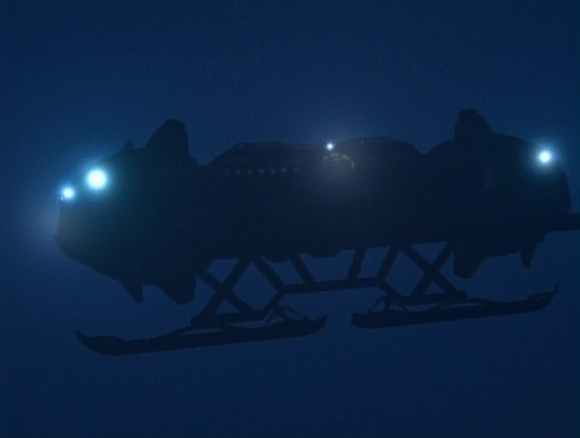
Comparisons have made to Star Trek and I can’t argue this, but, much like the Enterprise, there are Shuttlecraft used to ferrying personnel around with an entire episode dedicated to a lost launch (akin to the Star Trek episode – The Galileo Seven) and again, this show definitely benefited from having the ‘berg attached because they had some realllllllly nice practical, full-size props…
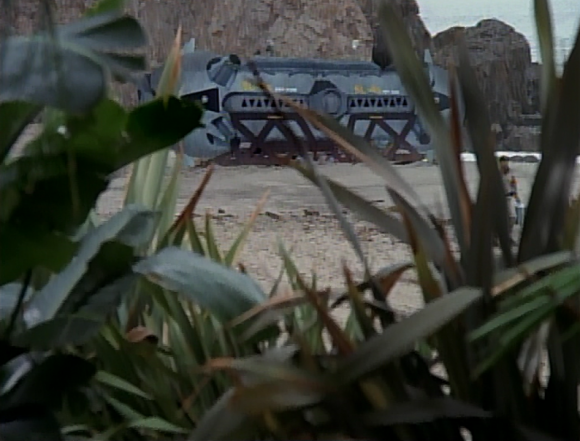
There were the Sea-Crabs which were a two-person utility vehicle used in repair, construction and excavation details:
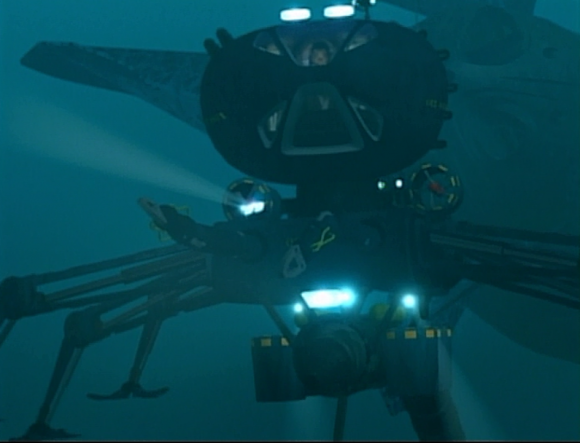
One of the more unique technical elements of the boat was the WSKRS (pronounced “whiskers”) an acronym that stood for “Wireless Sea Knowledge Retrieval Satellites.” These little probes traveled both in front and behind of SeaQuest and acted as periscopes and R.O.V.’s, feeding video and stills to the crew and the audience. I found it to be pretty clever and neat.
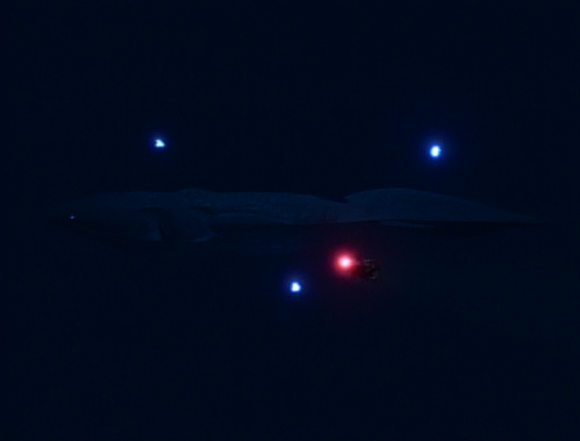
We also had Hitchcock’s Hyper Reality Probe that would come out and play sometimes, acting like the whiskers, only with four hands to manipulate things with.
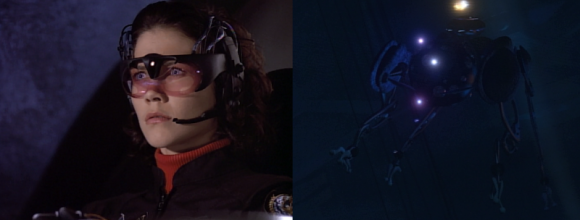
Another unique element to the SeaQuest was the texture of her hull. Expanded upon in the novels, the SeaQuest has a genetically-engineered biological “skin” on it that is bacteriologically inert (meaning it can’t affect the ocean and the ocean can’t effect it). The idea is that whenever the SeaQuest took damage, this layer would scab over, like a wound, and seal it until repairs could be made proper.
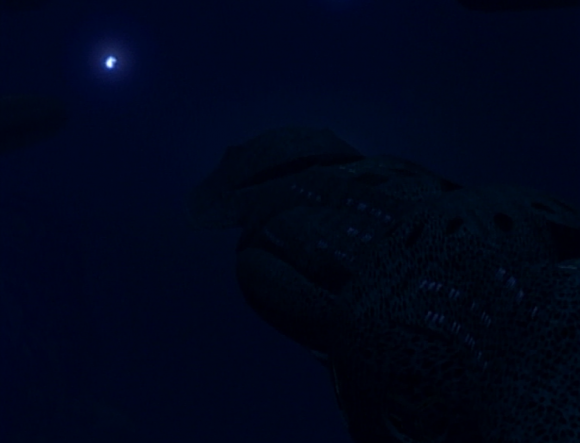
See? Cool ideas.
And that score!
That rousing main title theme, composed by John Debney, was simply brilliant! I remember during marching band when the choreography for color guard was being tweaked, the brass and woodwind sections would be trying to play the theme by ear. Just about everybody I knew was watching it, surprisingly, a lot of the girls, which made it easier to talk to them.
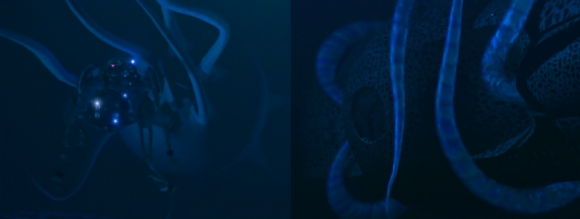
The first season dealt mostly with science fact and science future. Yes, there was an episode with an obligatory giant squid; it’s SEA-Quest after all and it’s expected, Nemo or not, that you’re gonna’ run into that shite at 50,000 fathoms or whatever. They also had an episode with ghosts that was handled intelligently if not ambiguously with the crew wondering if they really experienced paranormal activity or if it was the result of nitrogen narcosis from exploring a Titanic-like wreck. Even aliens were explored in a single episode, but it was done very low-key.
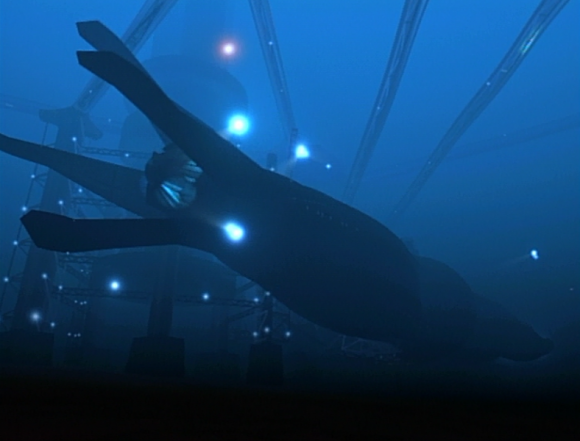
A prime example of a typical SeaQuest episode, and, probably my favorite, was “Bad Water” which focused on a downed sight-seeing submarine at the bottom of the Bermuda Triangle. It’s one those disaster episodes, where Murphy’s Law is in full-effect what with hurricanes, karstification sink holes, and magnetic disturbances. It also showcases most of the cast and gives them a chance to shine, whether it’s O’Neill utilizing his linguistic skills, Ortiz and the whiskers, and Chief Crocker boosting morale after a lightning strike with old school sea-shanties, everybody in the episode gets used to a high-degree and there’s plenty of action both on and below the surface.
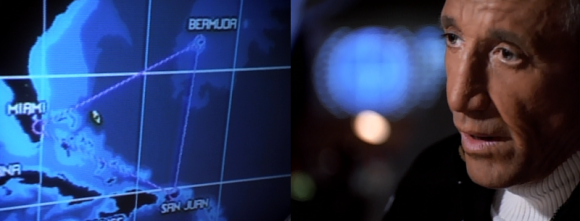
Even the dude from Psych*** shows up as one of the civilian scientists!!!
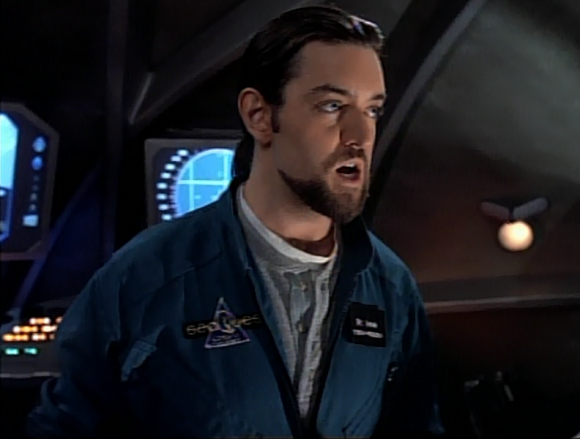
There were episodes on political intrigue (The Good Death; last Lap at Luxury), monsters of the week (the afore-mentioned Treasures of the Tonga Trench; Knight of Shadows) and some good, old fashioned disasters (The Devil’s Window; the season finale Higher Power).
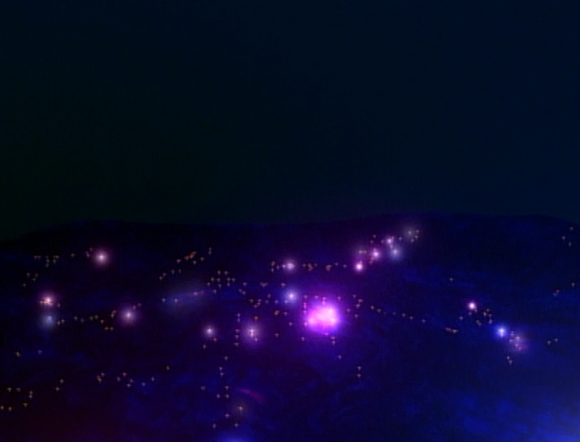
Tonga Trench also featured glowing squid fecal-pellets. You can’t get more awesome than glowing cephalopod shit! Well, actually, you can:
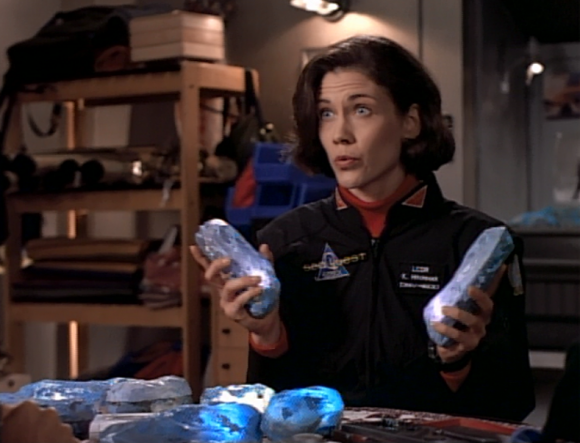
Not all the special effects in SeaQuest were computer-generated. Some were completely… how to put this… natural?
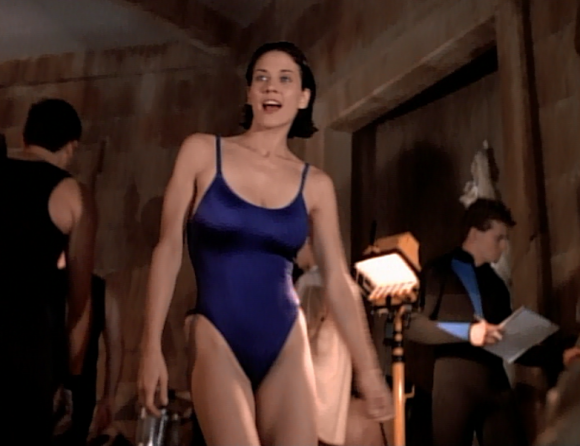
If any argument could be made as to its flaws, first season, it’s that the show was written and geared towards family viewing. Eight P.M. on a Sunday was destined for a TV-PG rating and such there was little to no violence. Guns were seen, carried and even fired, but rarely were there any casualties and if so they were off-screen.
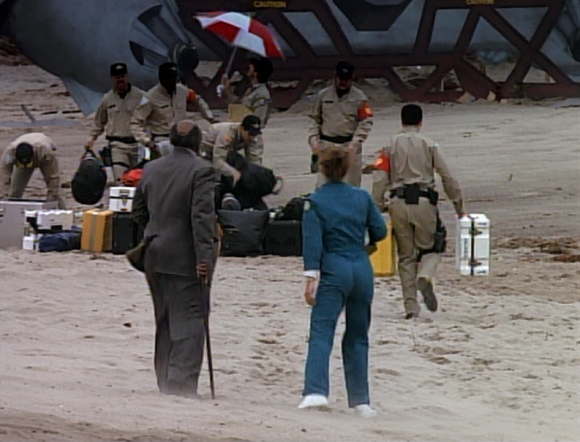
Despite having a fuggin’ dolphin, one would expect there to be an environmental message, and there was, to be sure. There was an episode where Bridger resigns because the SeaQuest is assigned to take out an anti-whaling vessel that has been sinking whalers. Bridger sided with them, but, thankfully, he gets his balls back the end of the episode. Looking back now, all the ecology episodes have the ecologists as the bad guys. That’s pretty awesome, actually, as in my experience, the most awful people usually think they’re acting with the best of intentions.
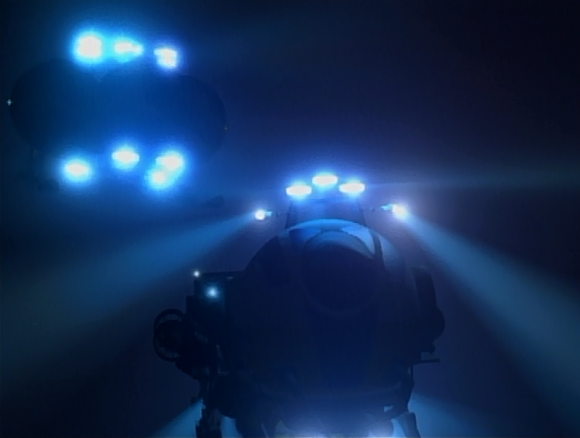
The special effects were exceptional for their time. Rendered on a Video Toaster and utilizing Lightwave 3D, SeaQuest was the first show completely rendered without model work; everything was done in the computer and with software. Cutting edge at the time, however, there are some episodes…
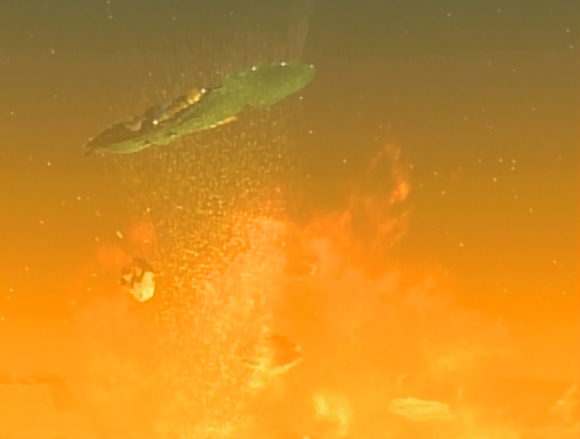
…like Higher Power (infamous, as season finales go, as they actually fuggin’ sunk the SeaQuest; that takes balls to end your show with the death of the star character and to be fair, the ship is the whole reason we were watching show), where the magma and rocks LOOK CGI and more at home in a Playstation-era game.

Most of the of the SeaQuest submarine sequences take place in a blue-gradient environment and so the beauty-shots still hold up well, as do those of the Sea Launches and other external shots.
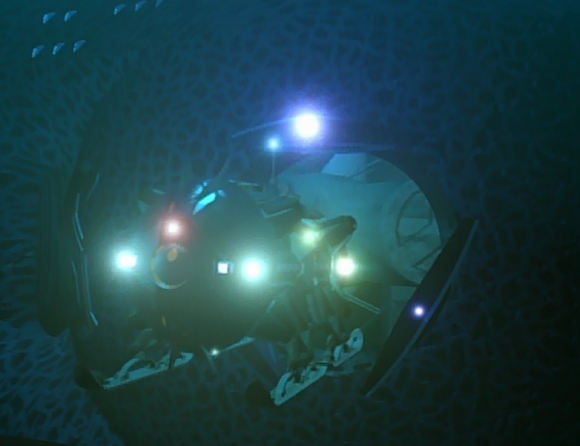
Speaking of effects – I never realized until years after the show’s cancellation that Darwin wasn’t a real dolphin! That little shit was 100% animatronic! My hats off to Walt Conti, who built and designed him. I should’ve expected nothing less as Conti is the go-to guy in Hollywood specifically for animatronic, practical marine life, having created the whales George and Gracie for Star Trek IV and the shark assortments for Deep Blue Sea.
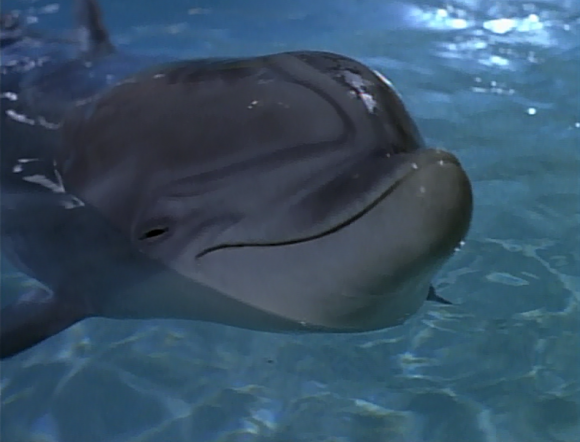
One last bit of cool, story detail was that, had SeaQuest lasted and retained its format established in this first season, each season would be like a “tour” on a military boat; the end of each season would be the end of that particular tour and it would give the writers a chance to keep existing characters or swap out with new characters, much like on a real ship. A neat idea that would be half-assed realize. I should also point out that SeaQuest boasted a pretty impressive list of guest stars, including Captain Kirk himself, William Shatner, David Morse, David “Ducky” McCallum and even Charlton Heston. CHARLTON FUGGIN’ HESTON!!!
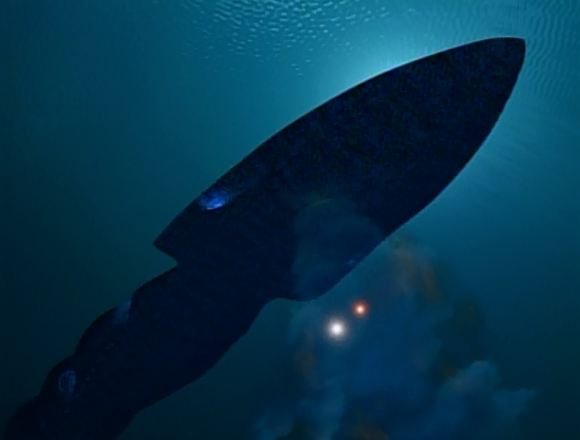
Why did SeaQuest fail and why is it much-maligned twenty-some odd years later?
First off – too many cooks…
Spielberg had his idea of the show; Roy Scheider had his and Universal had theirs. So did NBC who was also footing some of the bill. While the first season achieved respectable ratings, NBC wanted higher. Also, Spielberg became bored with the science-fact basis of the episodes, mandating the second season explore traditional, straight-up science fiction. This gave us some gems like unthawed, giant, prehistoric crocodiles, carnivorous, man-eating plants, giant, fire-breathing worms and aliens. Lots of aliens. Roy Scheider was understandably pissed off and very vocal to the news outlets, going so far as to call the shows “Tired, old, sci-fi, Saturday-matinee crap. Star Trek does this stuff better than we ever could and if I had wanted to be on the fourth iteration of that show, I’d have signed up for it!” Scheider was a big proponent of the science-fact and an intelligent, peaceful Captain who would look for alternatives to combat. He also, unsuccessfully, to try get some over-arching stories that would run throughout the entire season, rather than the non-connected, episodic format they went with. He also pushed for more character-based episodes that would show that the crew had lives outside the boat and in the world.
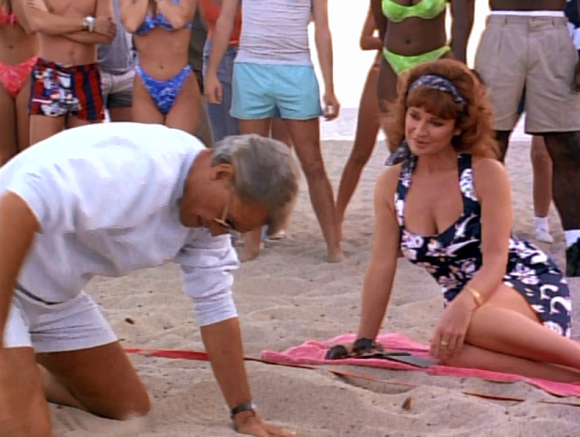
Two – studio meddling, as it was decided that filming would move from Hollywood to Florida at Universal Studios Orlando. Immediately, Stacey Haiduk and Stephanie Beacham refused to relocate, the former having lived there already for four years while making Superboy and she was reluctant to leave again. The latter was one of the fan-favorites of the cast and this was a harsh blow. Royce Applegate and John D’Aquino (Whose character of Ben Krieg, in my opinion, was one of the strongest characters of season one who proved to be both dramatic whilst provided some much need comedic relief) were released as the studio wanted younger (Applegate was fifty-something whereas D’Aquino was only thirty-six).
Basically, they wanted more hip; less nerdy.
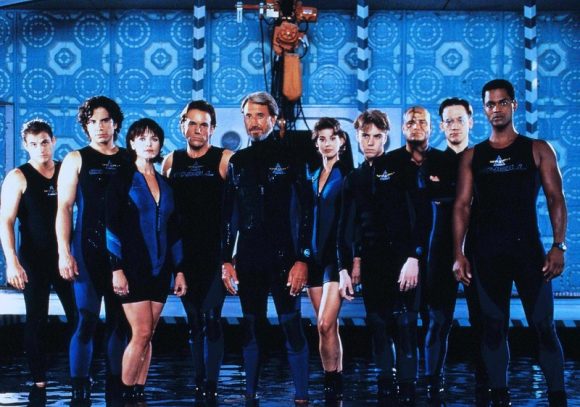
In their places we got the adorable Kathy Evison as tomboy Helmsman Lt. Lonnie Henderson; Edward Kerr as cocky weapons expert James Brody (a nod to Scheider’s character from Jaws), Michael DeLuise as Tony Piccolo – a screw-up given gills and the exquisite Rosaline Allen as Psychic and Medical Doctor Wendy Smith…
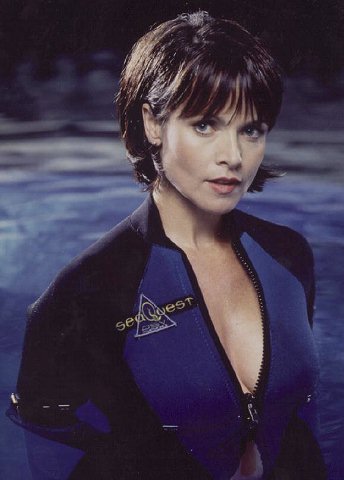
…which, like I said, was probably the only GOOD thing about season two!
With more fantastic elements at their disposal, a younger more attractive cast (Rosalind Allen was a FOX!) SeaQuest was sure to finally be a hit…
… except this didn’t happen and as a result, due to failed ratings, SeaQuest was to be cancelled in May of 1995. Scheider was released from his contract, but, when the show that would’ve taken SeaQuest’s place fell through, NBC picked up SeaQuest for one last season. Scheider’s deal was changed to reflect this. While he was no longer principal cast, the network required he make at least three appearances throughout the third season in a Guest Star capacity. Rosalind Allen (sad face emoticon) was released as her character proved to be unpopular with audiences (she was popular with this audience!) and Michael Ironside was brought in to replace Scheider as Captain Oliver Hudson – a polar opposite of Bridger as he was a career military man, hardened and strict. In fact, he made Lucas enlist if he wanted to stay aboard SeaQuest. The series also jumped ahead ten years; in the season two finale, the SeaQuest had been warped to another (conveniently aquatic) planet to help fight in an intergalactic war.
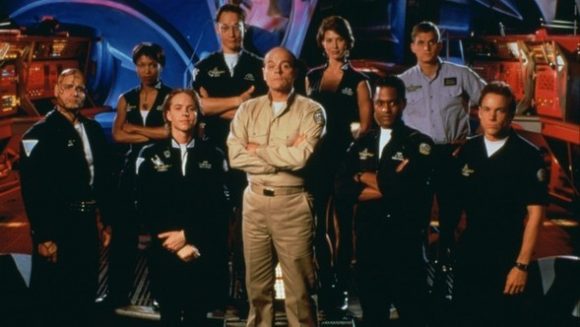
In its absence, all those federations got out of hand and things had gotten worse since the beginning of season one. Add to this a multi-national corporation doing all sorts of shady, corporational shit: white collar thug-life – illegal experimentin’, weapons profiteerin’, iceberg stealin’ (I’m not joking; Lt. Krieg was even featured in this one on the iceberg) and you had a world on the brink of disaster! The Australian Macronesian confederation wasn’t helping, either. SeaQuest reappeared on Earth 10 years later in a cornfield and with the crew scattered; Bridger having gone into hiding. Needless to say, Hudson gets her back and into the water and so begins season three. With a focus on the military aspect for this season, Ironside got to negotiate terms before signing on, saying “You won’t see me fighting any man-eating glowworms, rubber plants, 40-foot crocodiles and I don’t talk to Darwin.” The series looks and feels darker and has more serious tone. They did bring in one episode that had some time-warp crap where they go back to the Cuban Missile Crisis but that was the exception not the norm. One of the better episodes of season three, Equilibrium, harkens back to season one with a bacterial plague killing marine life that Bridger and the SeaQuest had released twelve years prior to BOOST plankton. Bridger insists that the bacteria will die, but, Lucas, arguing with his old mentor counters that they can’t wait that long and creates an antidote that makes the situation worse. However, despite the course correction, SeaQuest just wasn’t garnering ratings and season three was cancelled after episode thirteen aired.
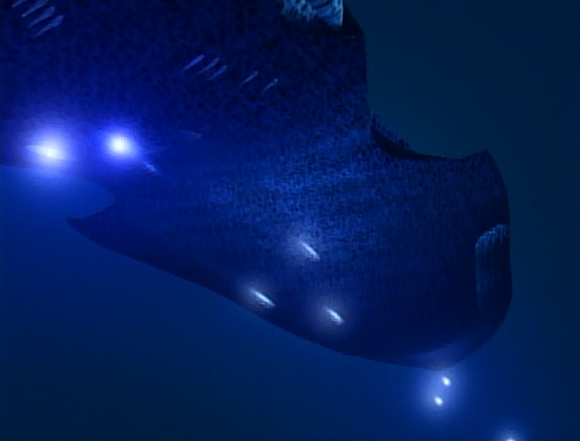
What could have been done to save this sinking ship?
Reflecting and musing, I think what NBC and Amblin should’ve done was stayed the course with season one. Any television show has a sluggish first season. It’s like that old analogy to sex; the first time is always awkward. There’s trying to find your show’s rhythm; it’s balance. The actors often have a struggle to find their character’s true voice and role. Between the pilot and episode three, little details aren’t even fixed yet; none of the jump suits have chevrons denoting rank until episode four or five. We have some characters, like Weapons Officer Bachmann, who appears in the pilot, doesn’t show up again until episode six and then only in the last four along with Lt. Shan (Dustin Nguyen). There was also the bald French dude who’s name escapes me.

I think had the producers not tinkered with the show, kept the cast and kept filming in Hollywood, SeaQuest would’ve proved to have had a stronger season two. I love the great, grand beard, but Spielberg isn’t that great of an idea man or a writer. He’s awesome with visuals, however. I think if he’d have been hands off on the scripts and actually, kept series creator O’Bannon on as a script supervisor, editor, you’d have gotten a lot more cohesive show.

Currently, all three seasons are streaming on Netflix. Definitely watch the first season; skip season two entirely and watch the season three episodes “In the Company of Ice and Profits” and “Equilibrium” as they bring a good sense of closure to the series.
* The United Nations is great and works wonderfully in Kaiju flicks and Global Natural Disaster epics, but, in real life? Not so much…
** My Naval bud, who’s a genre fan, never really got to sit down and watch it. When I told him about the show, he stopped me, saying “Whoa – back-up! This thing is armed? I thought it was all new-age, preachy, scientific exploration crap!”
*** Yeah, yeah, yeah, I know his name’s Timothy Omundson, but I just wanted to say “The dude from Psych.”

I suppose you have a better thought on the subject?